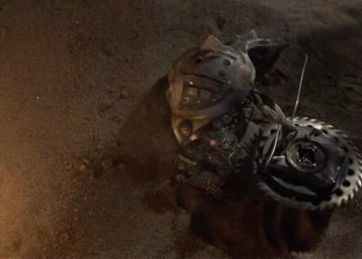Science Fiction
Dictionary
A B C D E F G H I J K L M N O P Q R S T U V W X Y Z
'Sandfish' Robot Moves Through Sand

A new sand-diving robot based on the sandfish lizard has been developed by a team led by Daniel I. Goldman, a physicist at Georgia Institute of Technology.
The sandfish lizard tucks in its limbs and wiggles forward with a whole-body sinusoidal traveling wave motion. Take a look at this video to see how the robot imitates the living organism.
(Sandfish robot video)
the team built a 35-centimetre-long version of the robot, made from seven aluminium segments linked by six motors, all clothed in spandex to prevent the motors from becoming jammed.The team then tested their robot by burying it in a container filled with plastic spheres 6 millimetres across. When the robot undulated its body at a frequency similar to the lizard, they found it could move forward at speeds of up to 0.3 body lengths per wave cycle - just below the 0.4 body lengths per cycle that a submerged lizard can achieve.
The intent is to create robots that can easily move through rubble to find and rescue people trapped in earthquakes or other catastrophes.
Science fiction writers (and readers) tend to find more sinister uses for robots that move easily through the earth and sand. For example, the claws from Philip K. Dick's 1953 story Second Variety are described burrowing upward from underground robotic factories - they "run and burrow."

(Claws - or Screamers - from the 1995 movie)
Consider also the robot earthworms from Harry Harrison's 1962 short story War With The Robots.
Read more about the sandfish lizard-based robot research and see the more recent New Scientist article.
Scroll down for more stories in the same category. (Story submitted 6/26/2010)
Follow this kind of news @Technovelgy.| Email | RSS | Blog It | Stumble | del.icio.us | Digg | Reddit |
Would
you like to contribute a story tip?
It's easy:
Get the URL of the story, and the related sf author, and add
it here.
Comment/Join discussion ( 0 )
Related News Stories - (" Robotics ")
Proof Of Robothood - Not A Person
'Who are you people? - Show 'em.' - James Cameron (1984).
Dancing Robots Taught Dance Moves
'A clockwork figure would be the thing for you...' Jerome K. Jerome, 1893.
Factory Humanoid Robots Built By Humanoid Robots
'...haven't you a section of the factory where only robot labor is employed?' - Isaac Asimov (1940).
Mornine Sales Robot
'Robot-salesmen were everywhere, gesturing...' - Philip K Dick, 1954.
Technovelgy (that's tech-novel-gee!) is devoted to the creative science inventions and ideas of sf authors. Look for the Invention Category that interests you, the Glossary, the Invention Timeline, or see what's New.
Science Fiction
Timeline
1600-1899
1900-1939
1940's 1950's
1960's 1970's
1980's 1990's
2000's 2010's
Current News
Natural Gait With Prosthetic Connected To Nervous System
'The leg was to function, in a way, as a servo-mechanism operated by Larry’s brain...'
Spidery 'Walk Me' Toyota Autonomous Wheel Chair Like Star Wars
Walk along with the emperor.
Dancing Robots Taught Dance Moves
'A clockwork figure would be the thing for you...'
Proof Of Robothood - Not A Person
'Who are you people? - Show 'em.'
Indonesian Clans Battle
'The observation vehicle was of that peculiar variety used in conveying a large number of people across rough terrain.'
The 'Last Mile' In China Crowded With Delivery Robots
Yes, it's a delivery robot. On wheels.
Tornyol Microdrone Kills Mosquitoes
'The real border was defended by... a swarm of quasi-independent aerostats.'
PLATO Spacecraft, Hunter Of Habitable Planets, Now Ready
'I ... set my automatic astronomical instruments to searching for a habitable planet.'
Factory Humanoid Robots Built By Humanoid Robots
'...haven't you a section of the factory where only robot labor is employed?'
iPhone Air Fulfils Jobs' Promise From 2007 - A Giant Screen!
'... oblongs were all over the floor and surfaces.'
ChatGPT Now Participates in Group Chats
'...the city was their laboratory in human psychology.'
iPhone Pocket All Sold Out!
'A long, strong, slender net...'
Did The Yautja Have These First?
What a marvel of ingenuity the little device was!
Jetson ONE Air Races Begin, Can Air Polo Be Far Behind?
'If you're one of those rarities who haven't attended a rocket-polo "carnage", let me tell you it's a colorful affair.'
Will Space Stations Have Large Interior Spaces Again?
'They filed clumsily into the battleroom, like children in a swimming pool for the first time, clinging to the handholds along the side.'
Mornine Sales Robot
'Robot-salesmen were everywhere, gesturing...'
